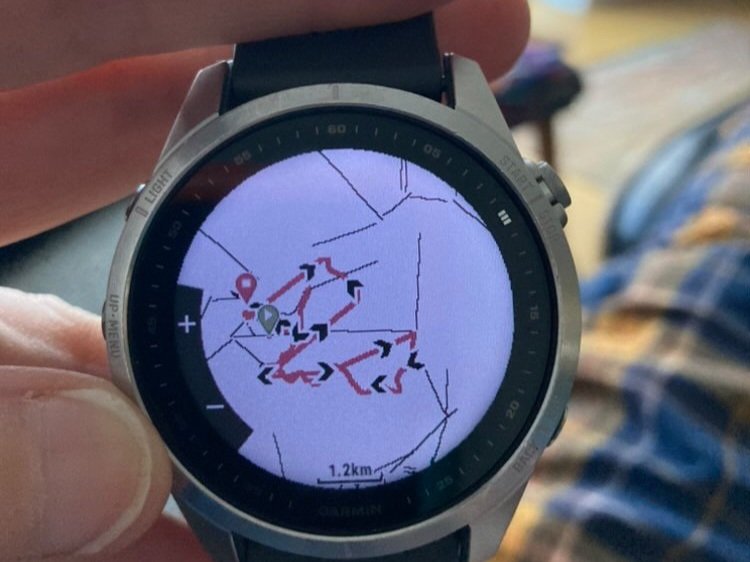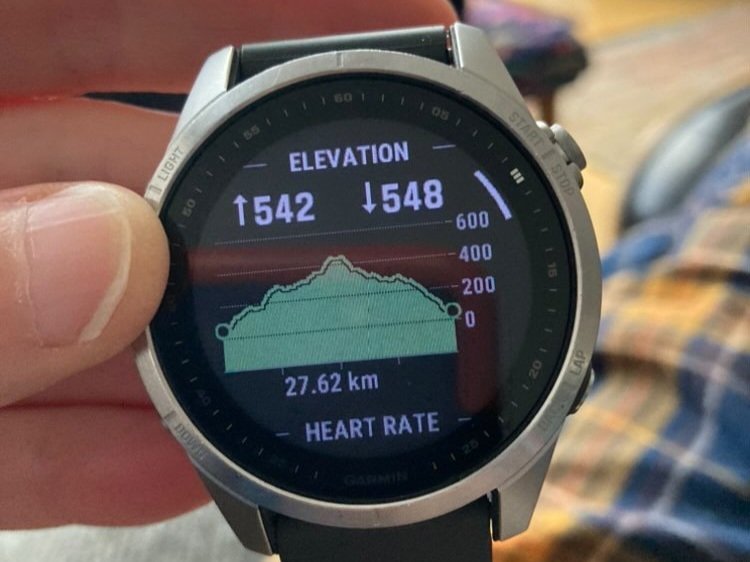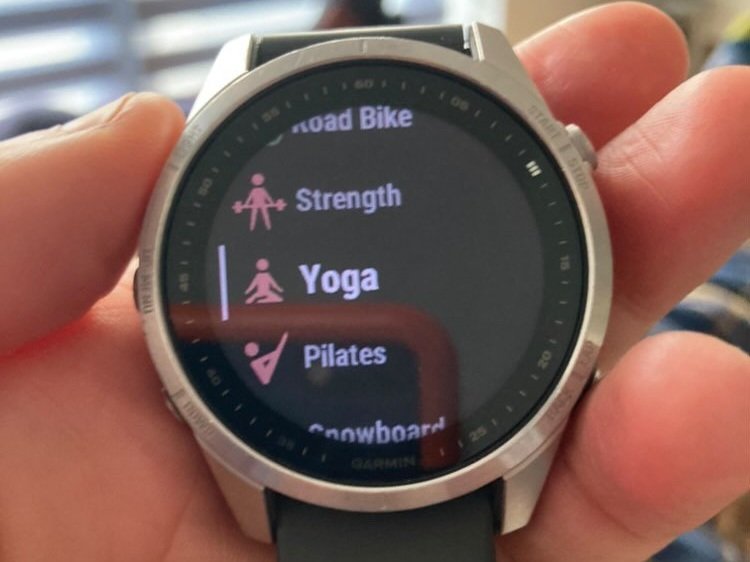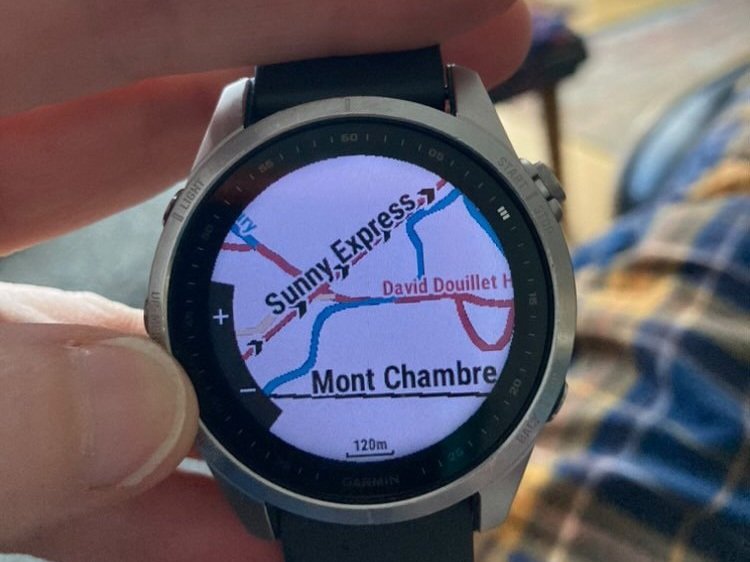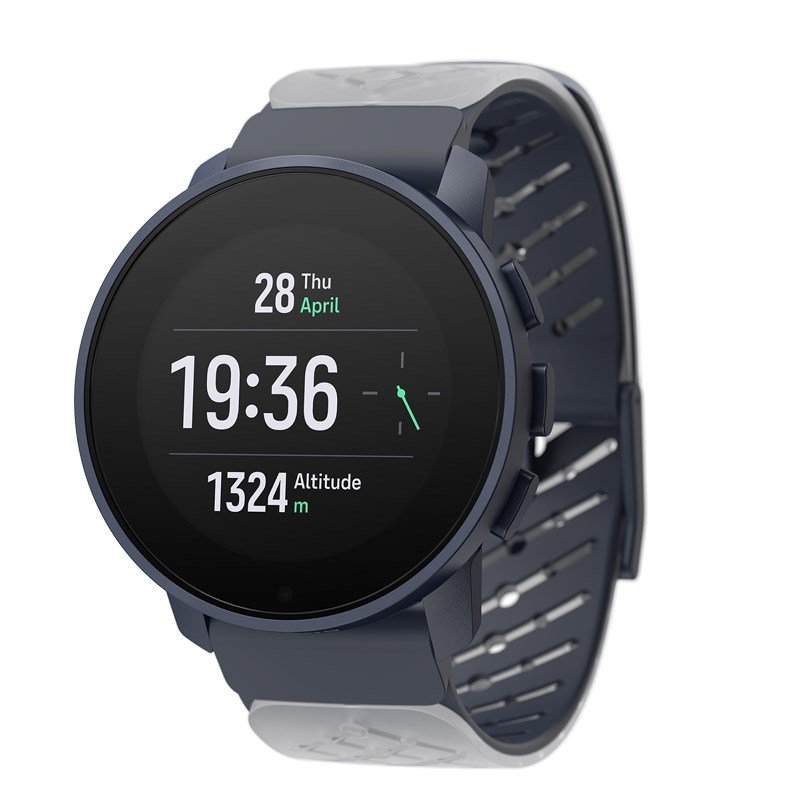Best outdoor GPS watches for small wrists 2024
This post may contain affiliate links, including Amazon Associate links, which means I may receive a small commission at no extra cost to you if you purchase through a link.
Please see my policy on affiliate links.
Suunto Race watch - the line across is just a shadow
A few weeks ago, I began delving into the confusing world of GPS watches. I wanted a watch that could handle navigation in the hills. But, knowing the way my brain works, it was also important for it to have the context of a map rather than just an arrow a black background.
I had some secondary wishes too. Things like step counting, route importing and recording, heart rate monitoring, compass, and altitude. As a bonus, if it could tell me when I was over training, all the better.
Did I mention that I wanted all this in a watch small enough to feel comfortable on my 15cm wrist, but big enough to read the maps and text. Oh, and ideally priced under £400. Easy peasy, right!
To be honest it was confusing AF! The smaller and lighter watches didn’t have the features. The watches with mapping were super expensive and chunky. And don’t even get me started on the overwhelming options offered by Garmin.
I headed to Instagram and asked people which watches they used. Their answers were helpful, but only added to my overwhelm.
I decided the data needed some kind of organisation, so took the only sensible step and created a spreadsheet comparing features, sizes, and prices. My spreadsheet loving friend would be proud 😇
My pick of GPS watches for small wrists
With my trusty spreadsheet in hand, I narrowed the search to a handful of watches priced under £450. But then the beast grew as I delved deeper.
I discovered that the best GPS watch for a small wrist will mean a compromise somewhere. Making a choice is all about balancing the features you want most with the sizes available, at a price you’re happy to pay.
I picked eight possible watches with differing features and price points to look into more. The wide range of options helped me work out my ‘must haves’ and know where I could compromise.
The spreadsheet also includes a couple of watches I discounted for size or price, plus a couple of older Garmin Fenix models which had been recommended. So, even though they’re not covered in this post, I figured it was worth keeping them on the spreadsheet in case you’re interested in knowing more.
Eight GPS watches for outdoor navigation
Click the links to jump down to that section
Coros Apex 2 | Price when reviewed £349.00 | Check price at Amazon | Small watch with great navigation features
Garmin Fenix 7s | Price when reviewed £519.99 | Check price at Amazon | Small watch with base maps
Garmin Forerunner 265s | Price when reviewed £429.99 | Small watch and lightest in test
Garmin Forerunner 965 | Price when reviewed £599.99 | Check price at Amazon | Lightweight for the features
Polar Pacer Pro | Price when reviewed £289.00 | Check price at Amazon | Lowest price in test
Polar Vantage V3 | Price when reviewed £519.00 | Check price at Amazon | Polar’s top of the range with mapping
Suunto 9 Peak Pro | Price when reviewed £315.00 | Check price at Amazon | Multi-sport watch aimed at small wrist sizes
Suunto Race | Price when reviewed £389.00 | Check price at Amazon | Great price, especially for the features and mapping
Note: Suunto have now released a Suunto Race S
For consistency, I took the prices from manufacturers’ websites. They’re accurate at the time of writing this post, but prices do change. Also look around online, you may find better deals.
Side note: I contacted Coros, Garmin, Polar, and Suunto to request a test watch over a four-week period for this article. Sadly, I had no reply from Coros or Garmin, and Polar didn’t have one available at the time. But Suunto kindly sent over a Race.
Coros Apex 2
Price when reviewed: £349.00 | Check price at Amazon
This is a small and relatively lightweight watch with great navigation features. It has a sapphire glass screen, titanium bezel, and is suitable for use in water up to 50m depth. The scrolling button on the dial is made to be used with gloves. The Apex 2 receives signals from the five major satellite systems, and has free global offline maps.
Pros: Smaller watch with base mapping and navigation features..
Cons: Online reviews talk about poor screen clarity and problems with accuracy.
Weight: 53g
Size: 43.0 x 42.8 x 12.8 mm
Display: 1.2 inch
Find out more: Apex 2 on Coros website
Garmin Fenix 7s standard edition
Price when reviewed: £519.99 | Check price at Amazon
This a smaller version of the Fenix 7, with great outdoor features and downloadable maps. Garmin also offers Livetrack and incident alert features which are great for solo adventures. It came highly recommended in the comments on my Instagram post. I tried one on in a shop and thought it was super comfy and lightweight, but can’t comment on the screen resolution and features as there were no test models to switch on.
Pros: Small and lightweight watch with mapping and Garmin navigation features.
Cons: More expensive than others tested. This video review also mentions low screen resolution and small display size.
Weight: 63g
Size: 42 x 42 x 14.1 mm
Display: 1.2 inch
Garmin Fenix 7s in action, kindly sent to me via Instagram for this post
Find out more: Fenix 7s standard edition on the Garmin website
Garmin Forerunner 265s
Price when reviewed: £429.99
This is a super lightweight watch with some great features and AMOLED display. I tried on a Forerunner 255s which is the same weight and couldn’t tell I was wearing it. The compromise is in the lack of mapping on the watch but if that’s not something which bothers you, go check it out.
Pros: The lightest watch in this comparison, with good navigation features.
Cons: No base mapping on the watch.
Weight: 39g
Size: 41.7 x 41.7 x 12.9 mm
Display: 1.1 inch
Find out more: Forerunner 265s on the Garmin website
Garmin Forerunner 965
Price when reviewed: £599.99 | Check price at Amazon
If you’re looking for a lightweight Garmin watch with a big display and built-in maps, the Forerunner 965 is worth a look. It has a high definition AMOLED display and is aimed at runners wanting advanced training metrics and recovery insights.
Pros: Lightweight with in-built maps and great navigation.
Cons: Bigger watch and the most expensive in the comparison.
Weight: 53g
Size: 47.1 x 47.1 x 13.2 mm
Display: 1.4 inch
Find out more: Forerunner 965 on the Garmin website
Polar Pacer Pro
Price when reviewed: £289.00 | Check price at Amazon
The Polar Pacer Pro is a small, lightweight sports watch. It has GPS and some great features making it worth a closer look for anyone wanting a lower priced watch. But it does mean compromising on some of the features found on other watches in this test. For me, it’s more of an every day watch with health tracking.
Pros: Lower-priced fitness tracking watch with some navigation features.
Cons: No maps, trackback, touchscreen, or recovery data.
Weight: 41g
Size: 45 x 45 x 11.5 mm
Display: 1.2 inch
Find out more: Pacer Pro on the Polar website
Polar Vantage V3
Price when reviewed: £519.00 | Check price at Amazon
This is a GPS watch with advanced training and recovery tools, and downloadable topographical maps. The latter is a first for Polar’s watches, along with the AMOLED display and dual-frequency/multiband GPS. It’s a good looking watch with all the features I was looking for, but it comes with a higher price.
Pros: Lightweight, especially for the features. Has base mapping and recovery data.
Cons: Larger watch and more expensive, especially when compared against the Suunto Race.
Weight: 57g
Size: 47 x 50.8 x 14.5 mm
Display: 1.39 inch
Find out more: Vantage V3 on the Polar website
Suunto 9 Peak Pro
Price when reviewed: £315.00 (Titanium: £359.00) | Check price at Amazon
The Suunto 9 Peak Pro is a multi-sport watch aimed at smaller wrist sizes. It has all the features needed for outdoor activities, with the exception of built-in maps. The battery life is up to 40 hours in the best GPS mode and it charges from empty to full in one hour. It also ticks all the right boxes for sustainability.
Pros: Rapid charging, good battery, small and lightweight for the features found.
Cons: No mapping on the watch.
Weight: 64g (titanium is 55g)
Size: 43 x 43 x 10.8 mm
Display: 1.2 inch
Find out more: Suunto 9 Peak Pro on the Suunto website
Suunto Race
Price when reviewed: £389.00 (Titanium: £479.00) | Check Suunto Race at Amazon | Check Suunto Race S at Amazon
This is a classy looking watch with great features, especially for the price point. It’s marketed as a performance watch for racing and training, but it also has all the navigational features I want for walking in the hills. The scrolling digital crown is good for using with gloves, and the screen is easy to see both indoors and outdoors. Plus there are those sustainability ticks from Suunto.
Note that Suunto have released a Suunto Race S since writing this article 🙌
Pros: Great mapping and navigation, fast charging, and a competitive price.
Cons: Bigger than other watches with mapping in this test.
Weight: 83g (titanium is 69g)
Size: 49 x 49 x 13.3 mm
Display: 1.43 inch
Find out more: Suunto Race on the Suunto website
I tested this watch for a month, so you can read a more in-depth review on the Suunto Race here
Understanding the features found on GPS watches
If you’re new to GPS watches, some of the terminology you’ll find on the spreadsheet can be confusing. Brands may also use their own descriptive wording for features, making it even more complex.
I like to make life easy, so have given a quick explanation of some features found.
General
Watch face glass:
Sapphire glass is harder to scratch than gorilla glass. On the flip side, sapphire is more likely to shatter when dropped. And, whilst a perfect gorilla glass screen might survive a fall more often than sapphire, that’s not necessarily true for a scratched one. Confused? If glass is a concern, I recommend doing a bit more research.
Size:
I’ve included measurements for the overall size of the watch, the thickness (how far it stands off your wrist), display size, and weight. The display size is important because that’s how much screen you get to see.
Battery life:
I found this difficult in the comparisons because each brand talks about their battery life differently. But, most show a stand-by smart watch battery life, and another with all systems go on GPS. That said, some have settings for conserving battery, and others have solar built into the glass for charging on the go - although double check that the battery drain from mapping isn’t faster than the charging time from solar.
Touchscreen:
Many watches now include touchscreen for scrolling. Some also have rotating crowns to scroll while wearing gloves.
Following routes
Breadcrumb trail:
Following a route on your watch, keeping you on track with a downloaded route.
Deviation alert:
Letting you know when you’ve gone off route.
Back to start:
Gives you a straight line direction back to where you started an activity.
Track back:
Navigates you back to the starting point of your activity along the path you travelled.
Base map:
Downloaded maps on the watch to give context of your route.
Livetrack:
Generally a feature of Garmin watches and enables someone back home to keep an eye on your position. It’s useful when on a solo activity, but can also be done with other watches using the Strava app on your phone.
Incident alert:
Another Garmin feature where the watch detects when you have an incident and contacts your emergency number.
Outdoor features
Compass:
Uses GPS tracking to determine your direction.
Altimeter:
Used to to determine the altitude at your current location, based on atmospheric pressure changes. Note this can sometimes be skewed in windy weather.
Accelerometer:
A sensor measuring acceleration or the rate of change in speed - it’s used to track things like steps taken and distance travelled.
GPS systems used:
There are five possible systems: GPS (USA), QZSS (Japan), BEIDOU (China), GALILEO (EU), and GLONASS (Russia). The advantage of using all five is for accuracy and also backup if one of the systems becomes unreliable or cannot work.
Health tracking
Step counter:
Counts the number of steps you take in a day. With GPS, it can be more accurate as it tracks movement through satellite signals rather than arm movement.
Wrist based heart rate monitor:
GPS watches tend to monitor heart rate via your wrist. For more accurate data, some allow you to pair a chest strap with the watch.
Recovery data:
Different brands do this in different ways. Garmin has a count down timer telling you the optimal time to attempt another hard workout. Others give you a reading telling you similar information. The reading is based on data like sleep, stress, relaxation, and physical activity.
Other features
Water resistance:
Some watches allow you to dive, others are an indication that it’s ok to get wet in the shower or when surface swimming. Most are shown in metres, Garmin show theirs in ATM (10 ATM means 100 metres).
Memory:
MB is a smaller quantity than GB (MB is equivalent to one million bytes, GB one billion)
Display:
AMOLED display consumes less power and gives a more vivid picture. Matrix offers higher resolution to LCD. Some prefer MIP display to AMOLED outdoors. It’s another minefield which I recommend researching if it’s important for you.
Display resolution:
A higher resolution will show more detail on a map. But brighter screens often come at the cost of shorter battery life.
Choosing the best watch
As mentioned earlier, your choice of a watch - especially for a small wrist - will be a compromise of size, weight, features, and price.
I ended up going down an unexpected route, so thought it was worth sharing my rationale below.
Coros Apex 2:
This was a strong contender. But nobody I knew wore it, meaning I couldn’t get any in-person feedback. As it was an unknown brand for me, I looked at lots of online reviews and eventually decided against it for the reported display, speed, and app issues.
Garmin Forerunner 265s:
This was in the running (no pun intended) because of the size and weight. But the lack of mapping on the watch ruled it out.
Garmin Fenix 7s:
This was a serious contender and felt super comfortable to wear. But I was concerned about the text and screen size - it’s a valid concern for anyone with ageing eyes! The video link in the summary above, confirmed my worries. But then, the pictures sent in showing the display seem ok. If it’s one you’re considering, see if you can find anyone with one and take a closer look.
Garmin Forerunner 965:
This looked to be a great alternative and had all the features I wanted. But, it was a larger size with a heavy price tag, making it a non-contender.
Polar Pacer Pro:
The lack of mapping and general features made this a non-option in the end. It would have been a great watch for local running and fitness tracking but not something I wanted to take into the hills.
Polar Vantage 3:
I thought this was a worthy contender and I’d have loved to try it out on a test. But, with the larger size and price tag over £500, I took it out of the list.
Suunto 9 Peak Pro:
I loved the look of this smaller and lighter watch, but the lack of mapping made me discount it from the running.
Suunto Race:
This watch had everything I wanted, including free downloadable maps, and all at a great price - but I worried about the size (it’s the biggest and heaviest in the test). Then the Suunto team gave me an opportunity to wear the Race for a month. Whilst I was originally looking for a smaller and lighter watch, I soon got used to wearing the Race (and loved it).
This exercise showed me that there has to be a compromise somewhere.
You can:
Choose a lower-priced watch, knowing it won’t have all the features.
Get all the features, but expect to be wearing a bigger, heavier watch.
Find a lighter-weight watch, but accept it won’t have built-in maps.
I thought size and weight would be the biggest deciding factors for me, even over mapping. But, after wearing the Suunto Race for a month, I really did not want to send it back. So, I bought it instead!
Yep, you read that correctly!
I finally ended up choosing the biggest and heaviest out of the eight watches compared in this review. It just couldn’t be beaten for the mapping, features, ease of use, screen clarity, and price. Plus, the sustainability information and 100% carbon offsetting shown upfront against each watch struck an extra chord with me.
A month later, and I’m still super happy with the Suunto Race. If you want to know more, I’ve written a full review of the Suunto Race here.
Final thoughts and extra feedback from GPS watch wearers
I spoke to loads of people in my research, either in person or via social media comments and DMs. If you were one of them, thank you 🙏 it really helped both with my own decisions and in putting this post together.
I’d like to share some of their feedback with you:
Garmin Fenix 5s recommended by someone with a small wrist who says it has great functionality for all they do, plus it syncs to other apps used.
Someone has been able to download maps from another source to their Garmin Fenix 6.
The Garmin Fenix 7X has a good battery for long-distance events.
The Garmin Forerunner 255s recommended by someone who wanted a small, lightweight watch without the battery drain of AMOLED.
The Suunto Race was recommended by someone who cannot fault their experience of it. Battery life and offline maps swung it for them.
The great customer care in the UK from by Garmin swayed more than one person to keep upgrading their watch with them.
Garmin update older models with new software developments, so long as the watch has the capacity to take an upgrade.
A few people mentioned that the Garmin app is difficult to understand.
The Polar app interface is very easy to view and understand.
Polar have great resources such as nutrition and training information, plus inspiration via their blog.
Joining official Facebook groups and forums for the watch you’re interested in is recommended to get real user experiences of the pros and cons.
Some of the apps linked to a watch are more complex than others, so check whether you can get the information you want. Also look at user reviews to see how easy it is to use.
Finally, I also popped into the Apple shop to check out an Apple Watch Series 9. As you can imagine, it looked and felt great, but the in-watch mapping and resolution wasn’t good enough for using in the hills. It’s exactly what I expected, but I wanted to give it a go!
I’d love to know how you get on and which watch you choose. Feel free to add a comment if you find any extra information which you think will help other readers of this article.
Note: I received the Suunto Race free of charge for a 30-day trial and test before writing this review. However, as always, this is a 100% impartial summary of my thoughts, opinions, and experience. Following the test, I liked the Suunto Race enough to buy one for myself.
FOUND THIS POST USEFUL? SUPPORT THE SITE!
Hopefully you found this review helpful. I’m an outdoor enthusiast, just like you, looking for as much information as possible before making a purchase. I write reviews from my personal standpoint, so you get first-hand information. It takes a lot of hours to put together reviews, and a fair bit of unpaid work.
The comparison data on GPS watches for small wrists which I’m offering as a free PDF is not something I could find anywhere else in my research.
Please consider supporting more content like this by buying me a cuppa via my Ko-Fi account. Thank you if you can 🫶
Get new adventures sent directly to your inbox. Emails usually go out every other week.
SIGN UP TO MY NEWSLETTER
Outdoor-Girl is run by Jacquie Budd, an outdoor adventure and marketing content writer for brands that care about their impact on people and the planet.



